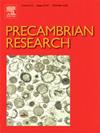The Rhyacian-Orosirian basement at the northeastern region of the Araçuaí orogen, Bahia, Brazil: Further evidence of an island-arc accretion followed by syn- and post collisional plutons during the São Francisco-Congo paleocontinent assembly
IF 3.2
2区 地球科学
Q2 GEOSCIENCES, MULTIDISCIPLINARY
引用次数: 0
Abstract
Granodioritic-tonalitic orthogneisses, together with granodioritic and high-K intrusions compound the Rhyacian-Orosirian basement units in the northeastern region of the Araçuaí belt, northeastern Brazil. These rocks were deformed and metamorphosed during the Neoproterozoic compressive event, but their genesis goes back to the Rhyacian-Orosirian times, when the São Francisco-Congo paleocontinent was amalgamated at the end of the Minas-Bahia orogeny (MBO). Field and petrographic data, twenty-two lithochemical analyses, three U-Pb (LA-ICPMS) zircon ages, zircon-in Lu-Hf and thirteen Sm-Nd analyses were conducted. Additionally, four previous U-Pb (SHRIMP) zircon ages were revised. The crystallization age of 2099 ± 14 Ma obtained for the granodioritic orthogneiss is close to the tonalitic-trondjhemitic granulites of the Buerarema complex in the cratonic interior (ca. 2.19 to 2.10 Ga). This fact, together with the similar lithochemical signatures, compatible with magnesian, calc-alkaline and sodic TTGs magmas, deficient in Nb, Ta, P, Ti, Y, YbN and enriched in LaN/YbN, suggest the extension of the Buerarema complex towards the interior of the Araçuaí belt, where it was reworked by the Neoproterozoic orogeny. The lithochemical signature observed for these orthogneisses is compatible with subduction-related magmas and the moderately juvenile signatures (ɛHf(t): −0.5 to −4.6; ɛNd(t): −1.6 to −4.6) suggest derivation from intraoceanic mature arcs. The presence of others ca. 2.1 Ga coeval arcs related to the Bahia-Minas orogeny (i.e.: the Rio Itapicuru, Costeiro, Rio Campim, Mineiro, Mantiqueira, Juiz de Fora and other arcs) not only corroborates with the interpretation of the pre-collisional Buerarema arc, but also suggest the presence of an expressive oceanic crust between the Archean blocks at ca. 2.1 Ga. One calc-alkaline and metaluminous granodioritic stock (2067 ± 5 Ma) and new mapped high-K shoshonitic granitoids (2025 ± 7 Ma) are intrusive in the Buerarema complex. Their isotopic record are indicative of crustal evolved rocks (ɛHf(t): −4 to −7; ɛNd(t): −2.8 to −3.0; and ɛHf(t): −7 to −14; ɛNd(t): −2.4 to −2.6, respectively) compatible with syn and post-collisional magmas of the MBO. Although the Paleoproterozoic age, the high content of Ba-Sr in concordance with the elevate ferromagnesian minerals and incompatible trace and REE elements allow the discussion if these intrusions are sanukitoid-like rocks.

求助全文
约1分钟内获得全文
求助全文
来源期刊

Precambrian Research
地学-地球科学综合
CiteScore
7.20
自引率
28.90%
发文量
325
审稿时长
12 months
期刊介绍:
Precambrian Research publishes studies on all aspects of the early stages of the composition, structure and evolution of the Earth and its planetary neighbours. With a focus on process-oriented and comparative studies, it covers, but is not restricted to, subjects such as:
(1) Chemical, biological, biochemical and cosmochemical evolution; the origin of life; the evolution of the oceans and atmosphere; the early fossil record; palaeobiology;
(2) Geochronology and isotope and elemental geochemistry;
(3) Precambrian mineral deposits;
(4) Geophysical aspects of the early Earth and Precambrian terrains;
(5) Nature, formation and evolution of the Precambrian lithosphere and mantle including magmatic, depositional, metamorphic and tectonic processes.
In addition, the editors particularly welcome integrated process-oriented studies that involve a combination of the above fields and comparative studies that demonstrate the effect of Precambrian evolution on Phanerozoic earth system processes.
Regional and localised studies of Precambrian phenomena are considered appropriate only when the detail and quality allow illustration of a wider process, or when significant gaps in basic knowledge of a particular area can be filled.
 求助内容:
求助内容: 应助结果提醒方式:
应助结果提醒方式:


